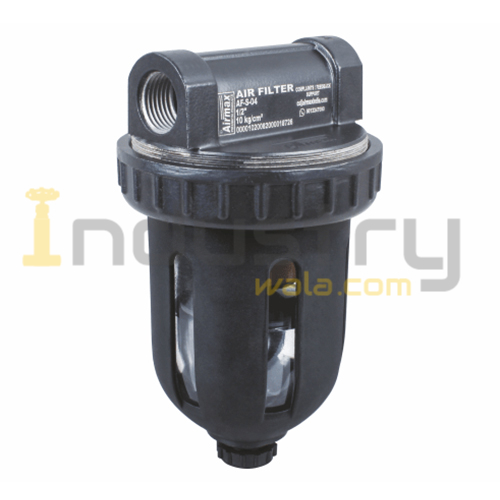- Shop all catagories
- Automated Valves
- Gauges & accessories
- Hydraulics
- Pneumatics
- Water Meters
- Manual Valves
- IBR Certified Boiler Valves
- Non IBR Boiler Valves
- Pipe Fittings & Flanges
Airmax Standard Series Air Filter
₹1,040 – ₹2,520
Brand : Airmax
Model- AF-S-02
Body : Aluminum Pressure Die Cast
Bowl : P.C Bowl with Guard
Element : Poly Porous (25 Micron)
Pressure : 10kg/cm2
Temperature : Upto 50 C
Media : Compressed Air
For low cost Aeroflex air filter, click here.
For Janatics air filter, click here.
For Airmax air filter, click here.
Product Information
Description
Additional information
Reviews
Description
What is a compressed air filter?
A Pneumatic air filter or air line filter is used to filter impurities from atmospheric air, like dust, oil and moisture, to make compressed air viable for use.
Just like air dryers, they are a crucial part of the air treatment process to make sure your compressed air is clean and safe to use, and to increase your equipment’s life span.
Proper air preparation significantly increases the process and production reliability of machines. Particles, water and oils in compressed air reduce the service life and functionality of components and systems. They also impair productivity and energy efficiency. In this article, a variety of air filtration and air treatment products are outlined and discussed, along with ancillary equipment like drains.
Why is a compressed Air Filter Necessary
One cubic foot of compressed air can contain millions of dirt particles, considerable amounts of water and oil — and even heavy metals like lead, cadmium and mercury. If they are not filtered out, trouble-free operation of the system components, like valves and cylinders, cannot be guaranteed in the long term. Poorly prepared compressed air can contaminate control valves, and cause seals to swell and wear prematurely. As a result, the right compressed air preparation is essential for reducing machine downtime, and for reducing maintenance and energy costs. Pneumatic Air Filters are used to remove particles, condensate and oil. Coarse / particulate filters have a pore size of 5 to 40 microns. The air flows past a centrifugal separator and then through the filter element. The filter elements are often a sintered material, like polyethylene or bronze. Fine and micro filters remove particles smaller than 1 micron, down to 0.01 micron. The air flows through the filter cartridges from the inside to the outside. Solid particles get stuck in the filter cartridge, clogging it up. Fluid particles, such as condensate or oil, coalesce or attach to larger droplets, which flow off and are caught in the filter bowl. It is important to cascade your filters to avoid prematurely clogging the filter element. For example, if 1-micron filtration is needed, it is recommended to use a 5-micron filter upstream so that the 1-micron filter does not become clogged with larger particles.Additional information
Reviews










